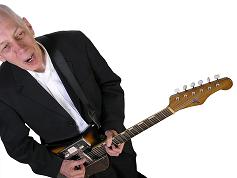|
Rod Clements saw considerable chart success with folk-rockers Lindisfarne, penning their hit Meet Me On The Corner. He currently works as a solo artist and with his band, The Ghosts of Electricity. He also collborates with other musical kindred spirits and has worked with the late, great Bert Jansch, Michael Chapman, Rachel Harrington and Rab Noakes, among others. We trust you’ll enjoy the latest of Rod’s regular musings in which you’ll find he’s
NICELY OUT OF TUNE

It’s hard to believe that Jools Holland’s Later has now been with us on BBC2 for twenty years. It has been rightly lauded as a benchmark in the presentation of live music on TV. But there are plenty of older programmes, good and bad, still knocking round to remind us of how things used to be. A question I am frequently asked (along with “Is ‘Meet Me On The Corner’ a drug song?” Answer: I can’t remember.) is how I managed to play bass and fiddle simultaneously on the Old Grey Whistle Test clip of ‘Fog On The Tyne’ – a programme that was supposed to be live. The answer, of course, is that I was miming – a practice more prevalent than many viewers realised, even on late-night shows for beard-stroking muso types.
Miming, back then, was generally considered to be the lesser of two evils by both musicians and TV producers. Various considerations, human and technical, made it hard to get a good live sound and the studio floor could be a battleground of conflicting interests and incompatible equipment. Musical interests sometimes took second place. Once you’d recorded your piece, playback in the control room – if you were given the chance to hear it – could be disconcerting. Considerations of time and cost rendered retakes unlikely, and all too often, requests to improve things were met with stony-faced assurances that the pictures were fine and that was all that mattered. So miming, or at least using pre-recorded backing tracks with live vocals, saved everybody a lot of grief.
An interesting side-effect of miming was the phantom recording session. Because miming theoretically deprived backing musicians of employment opportunities, the Musicians’ Union and the TV companies had an arrangement stipulating that all backing tracks had to be specially recorded for each programme. Artists would go into a proper sound recording studio with a bunch of session men who would all get paid, under the supervision of a union representative, and emerge with a tape of the backing track for use in the TV studio. That’s how it worked in theory.
In fact, the tape that went to the TV studio was usually the backing track from the original record and the session men were being paid to turn up and sit around chatting and reading the paper, and maybe footle around on their instruments a bit if anybody was watching. Somebody from the record company would be there to ensure that the niceties were observed, prying eyes distracted, and the correct tape handed over with due ceremony. This little charade happened every week in studios all over London; everybody got paid, the TV people were happy and audiences eventually heard the song with a real live new vocal over the high-quality backing track from the original record. I don’t know whether anything like that goes on nowadays. I suspect not, given the advances in live TV performance and sound reproduction, à la Jools, and the ubiquity of expensively produced, heavily marketed, company approved videos.
There will always be room for more quality live music on TV, but at least we now have the chance to see performances ranging from the sublime to the cringe-making, right from the earliest days of film and sound recording. Meanwhile, happy twentieth birthday, Later, and thanks for raising the bar for live music on TV. At least I can be reasonably certain now, if I’m playing in a TV studio, I won’t get asked (as I was once) to play higher up the neck so that the cameraman can get both my hands in the shot at the same time.
|